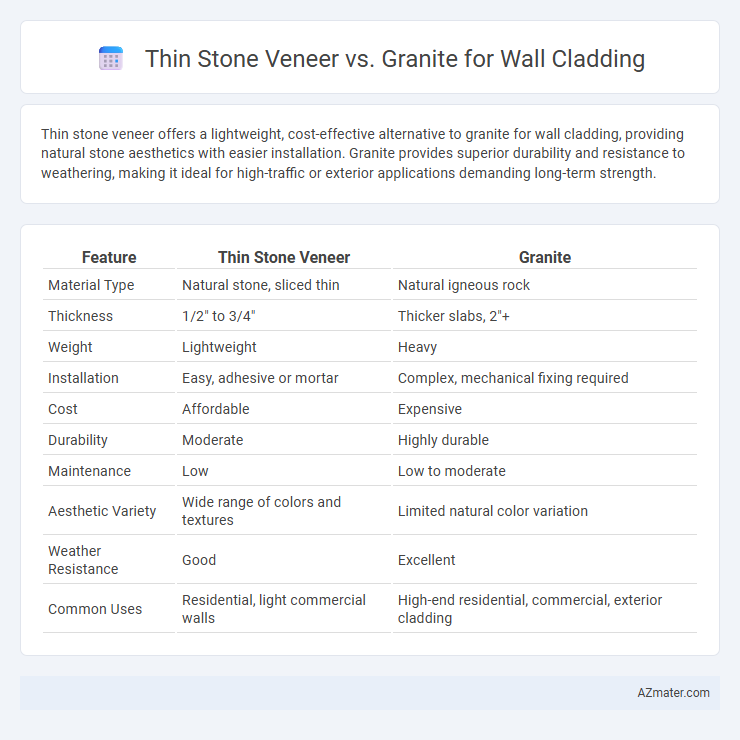Thin stone veneer offers a lightweight, cost-effective alternative to granite for wall cladding, providing natural stone aesthetics with easier installation. Granite provides superior durability and resistance to weathering, making it ideal for high-traffic or exterior applications demanding long-term strength.
Table of Comparison
| Feature | Thin Stone Veneer | Granite |
|---|---|---|
| Material Type | Natural stone, sliced thin | Natural igneous rock |
| Thickness | 1/2" to 3/4" | Thicker slabs, 2"+ |
| Weight | Lightweight | Heavy |
| Installation | Easy, adhesive or mortar | Complex, mechanical fixing required |
| Cost | Affordable | Expensive |
| Durability | Moderate | Highly durable |
| Maintenance | Low | Low to moderate |
| Aesthetic Variety | Wide range of colors and textures | Limited natural color variation |
| Weather Resistance | Good | Excellent |
| Common Uses | Residential, light commercial walls | High-end residential, commercial, exterior cladding |
Overview of Thin Stone Veneer and Granite
Thin stone veneer offers a lightweight, cost-effective alternative to traditional stone, featuring thin slices of natural or manufactured stone designed for easy installation on walls. Granite, renowned for its durability and natural beauty, presents a solid, heavy material with exceptional resistance to weathering and wear, often preferred for high-end wall cladding. Both materials provide distinct aesthetic qualities, with thin stone veneer enabling versatility in design and granite delivering a timeless, polished finish.
Material Composition and Structure
Thin stone veneer consists of natural stone slices typically 1 to 2 inches thick, composed primarily of sedimentary or igneous rock with a porous structure that allows for lighter installation. Granite for wall cladding is a dense, crystalline igneous rock made mainly of quartz, feldspar, and mica, offering superior durability and strength due to its interlocking mineral grains. The structural difference lies in veneer's reduced thickness and lighter weight, enabling easier handling, while granite panels provide greater hardness and resistance to weathering for exterior cladding.
Installation Process Comparison
Thin stone veneer offers a lightweight, easy-to-handle installation process that typically requires less labor and specialized equipment compared to granite slabs. Granite wall cladding demands precise cutting, heavy lifting, and secure anchoring due to its substantial weight and thickness, often increasing overall installation time and cost. Thin stone veneer adheres directly to various substrates with mortar or adhesive, while granite usually necessitates mechanical fasteners or support systems to ensure stability and durability.
Weight and Structural Considerations
Thin stone veneer offers a lightweight alternative to traditional granite for wall cladding, typically weighing between 8 to 15 pounds per square foot compared to granite's 15 to 20 pounds per square foot, reducing structural load requirements. This weight difference lessens the need for heavy-duty framing and reinforcements, making thin stone veneer ideal for retrofit projects and non-load-bearing walls. Structural engineers often prefer thin stone veneer in seismic zones or buildings with limited support capacity due to its reduced mass and stress on the underlying structure.
Design Versatility and Aesthetic Options
Thin stone veneer offers superior design versatility with its lightweight nature, allowing for intricate patterns and seamless installation on various surfaces, including curved walls. Granite provides a luxurious aesthetic with natural color variations and polished finishes that bring depth and elegance but is limited by heavier weight and thicker slabs. The choice between thin stone veneer and granite depends on balancing the desired visual impact with installation flexibility and structural considerations.
Durability and Weather Resistance
Thin stone veneer offers excellent durability and resists cracking and chipping due to its lightweight and flexible installation, making it suitable for various weather conditions. Granite, a natural stone, provides superior weather resistance with its dense, hard surface that withstands extreme temperatures, moisture, and UV exposure without fading or deteriorating. Both materials deliver long-lasting protection, but granite is often preferred for high-impact and harsh climates due to its unmatched robustness and weather resilience.
Maintenance Requirements
Thin stone veneer requires minimal maintenance with occasional cleaning and sealing to prevent moisture infiltration, making it ideal for cost-effective, low-upkeep wall cladding. Granite, known for its durability and resistance to staining, demands less frequent sealing but benefits from regular cleaning to preserve its natural luster and prevent etching. Both materials offer strong longevity, but granite's inherent toughness often results in a longer lifespan with less intensive upkeep compared to thin stone veneer.
Cost Analysis and Budget Factors
Thin stone veneer offers a cost-effective solution for wall cladding with prices typically ranging from $6 to $12 per square foot, making it suitable for budget-conscious projects. Granite, a natural stone option, commands higher expenses between $40 to $100 per square foot due to quarrying, heavy material weight, and complex installation requirements. Budget factors must consider not only material costs but also labor, installation time, and long-term maintenance, where thin stone veneer provides savings through easier handling and faster application.
Environmental Impact and Sustainability
Thin stone veneer offers a significantly lower environmental footprint compared to granite due to reduced extraction volumes and lighter transportation demands, which decrease carbon emissions. Its manufacturing process consumes less energy, promoting sustainability by minimizing quarry waste and allowing for more efficient resource utilization. Granite, while durable and recyclable, often involves intensive quarrying and energy usage, resulting in higher ecological disturbance and carbon output during extraction and processing.
Choosing the Right Option for Your Project
Thin stone veneer offers a lightweight, cost-effective solution ideal for both interior and exterior wall cladding, providing a natural stone look with easier installation compared to granite. Granite, known for its exceptional durability, resistance to weathering, and luxurious finish, suits high-traffic areas and projects requiring long-lasting material performance. Selecting the right option depends on budget, aesthetic preferences, structural requirements, and maintenance expectations specific to your project's environment and design goals.

Infographic: Thin stone veneer vs Granite for Wall cladding
 azmater.com
azmater.com